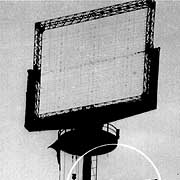![]() The Pacific War Online Encyclopedia
The Pacific War Online Encyclopedia
|
| Previous: Cuttack | Table of Contents | Next: D Class, British Destroyers |

National
Archives #19-N-32465-B
| Wavelength | 1.5 m |
| Pulse Width | 3 microsecond |
| Pulse Repetition Frequency | 1640 Hz |
| Scan rate | 5 rotations per minute |
| Power | 15 kW |
| Range | 70 nautical miles/130km (bomber) 50 nautical miles/90km (fighter) 16 nautical miles/30km (battleship) 12 nautical miles/20km (destroyer) |
| Antenna |
17' square 6x6 dipole "mattress"
array |
| Scope |
A scope |
| Accuracy | 300 yards (270m) 3 degrees |
| Resolution | 600 feet (180m) 3 degrees |
| Weight | 5000 lbs (2300kg), of which 1200 lbs (500 kg) was antenna |
| Production |
6 CXAM by late 1940 14 CXAM-1 by 1942 |
The CXAM1 naval air search radar was one of the first to see widespread use, being mounted on a few capital ships by 1942. It provided no altitude information and was heavy and bulky, but it revolutionized naval air defense.
The radar was a development of XAF, which was developed by the U.S. Naval Research Laboratory and first tested in a warship in 1938. It used a large rotating mattress antenna (17' square and consisting of 6x6 dipoles) and proved capable of air and surface search and even of spotting the fall of shells. The first production sets were ordered in October 1939. By 1940 these had been fitted to California, Yorktown, Chicago, Chester, Pensacola, and Northampton. By the time war broke out, additional sets were installed in the U.S. Navy's other carriers, five other battleships, and in the cruiser Augusta.
A curiosity of this radar was that its wavelength was short enough to restrict it to line of sight, but long enough for the technology of the day to modulate it. Thus, towards the end of the war, the radar doubled as a talk-between-ship communications system.
References
Guerlac
(1987)
Hezlet
(1975)
Naval
Historical Center (accessed 2009-6-6)
The Pacific War Online Encyclopedia © 2007-2010 by Kent G. Budge. Index